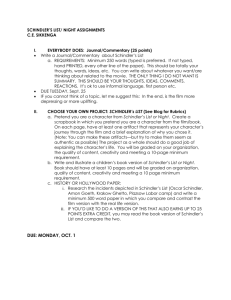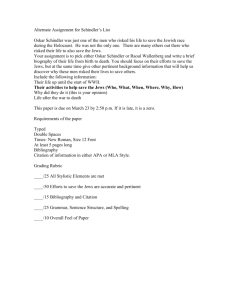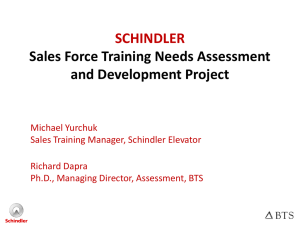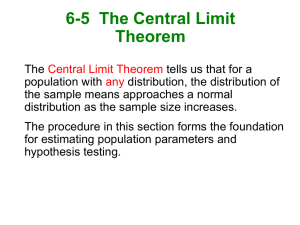Traffic Analysis Report Commercial Office Building
advertisement
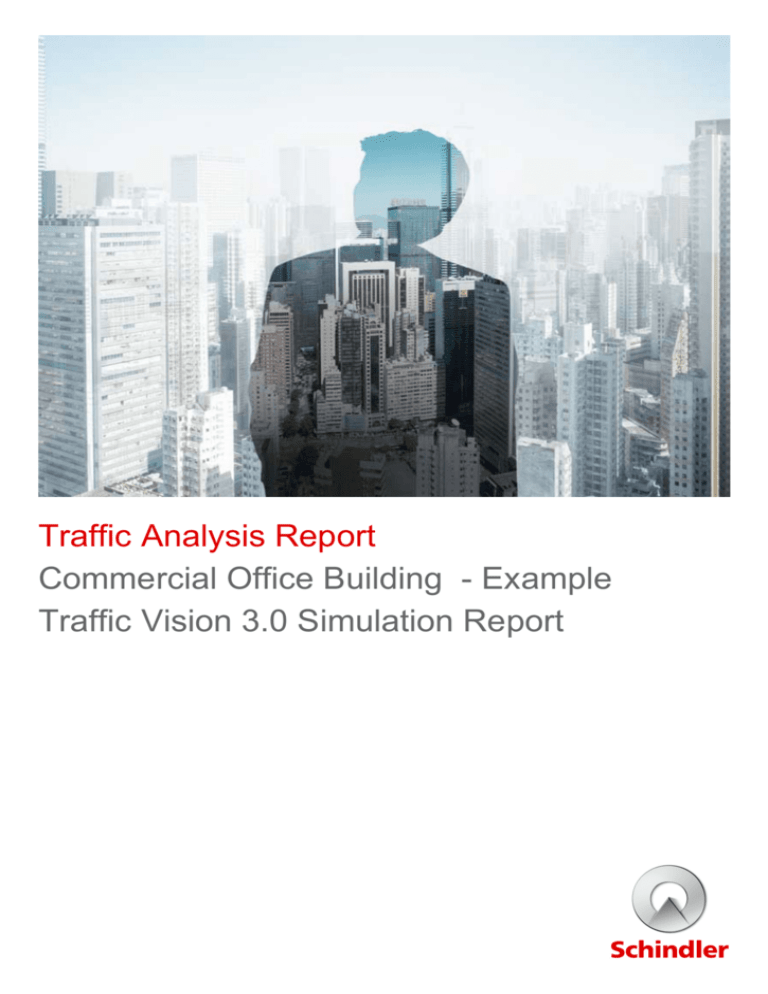
Traffic Analysis Report Commercial Office Building - Example Traffic Vision 3.0 Simulation Report 1 2 3 Summary Standards and Recommendations Results 5 6 8 9 4 3.1 Analysis 2 ___________________ 5 How Schindler Undertakes Traffic Analyses 4.1 Introduction _________________ 11 4.2 Measures and Definitions ______ 11 4.3 Methods of Traffic Analysis _____ 12 7 0 Schindler Limited Benwell House Green Street Sunbury on Thames Middlesex TW16 6QT This document has 13 pages. Created by Traffic Vision 3.0 (Schindler IX Version 1.9.8.1) Copyright INVENTIO AG, Hergiswil, Switzerland www.schiindlerlifts.co.uk Commercial Office Building - Example Traffic Vision 3.0 Simulation Report | 2 1 2 3 4 5 6 7 8 9 0 Summary Summary The purpose of this report is to show the level of results achieved when carrying out a lift traffic simulation using Schindler Trafficvision 3.0. Each simulation will be prepared and presented to our clients based on the data provided. We are able to prepare analysis which compares Schindler HCD Control with Conventional control systems. 1 Analysis 2 6 elevators Schindler ID 2.5 m/s 1600 kg Traffic Situation Floors Population Rating HC5 Up-Peak Lunch (Single Tenant) 0..15 0..15 1350 1350 15.0 % 20.0 s 13.2 % 29.1 s 4.0 4.0 WT DT IS 66.6 s 77.4 s 1.5 2.3 Please do not hesitate in contacting Schindler if you feel we can be of assitance in your building and vertical transportation planning. Commercial Office Building - Example Traffic Vision 3.0 Simulation Report | 3 1 2 3 4 5 6 7 8 9 0 Standards and Recommendations Standards and Recommendations Depending on the type of building, one or two of the following traffic situations are analysed: Traffic Situation Up-Peak Lunch Single Tenant Lunch Multi-Tenant Two-Way Hotel Two-Way Residential Incoming 100 % 40 % 45 % 50 % 50 % Outgoing 0% 40 % 45 % 50 % 50 % Inter-floor 0% 20 % 10 % 0% 0% Type of Building Office (all) Office (single-tenant) Office (multi-tenant) Hotel Residential For other types of buildings, an Up-Peak situation and optionally one of Lunch Single Tenant, Lunch Multi-Tenant, or Two-Way Hotel are analysed. Every analysis covers a full range of arrival rates, reporting handling capacity HC5 and average waiting time WT as main criteria. As a general guideline, Schindler defines a rating in the range of 0.0 (worst) to 6.0 (best) based on these criteria. Recommended ratings are 3.0 or higher: Schindler Traffic Analysis Ratings 2008 Traffic Situation Rating >= 3.0 HC5 WT Rating >= 4.0 HC5 WT Rating >= 5.0 HC5 WT Up-Peak Lunch Single Tenant Lunch Multi-Tenant Two-Way Hotel Two-Way Residential >= 12 % >= 11 % >= 11 % >= 11 % >= 6 % >= 14 % >= 13 % >= 13 % >= 13 % >= 7 % >= 16 % >= 15 % >= 15 % >= 15 % >= 8 % <= 30 s <= 40 s <= 40 s <= 40 s <= 80 s <= 20 s <= 30 s <= 30 s <= 30 s <= 60 s <= 15 s <= 20 s <= 20 s <= 20 s <= 40 s Ratings are also displayed by a corresponding number of stars and may be interpreted on a global basis as follows: Rating >= 3.0 >= 4.0 >= 5.0 Stars Office Standard office buildings Mid-to-higher requirements Premium sites Hotel Up to approx. 3-star hotels Up to approx. 4-star hotels Up to approx. 5-star hotels Residential Basic segment Medium segment Premium segment Commercial Office Building - Example Traffic Vision 3.0 Simulation Report | 4 1 2 3 4 5 6 7 8 9 0 Results Analysis 2 Building and Population Results 3.1 Analysis 2 3.1.1 Building and Population Number of Floors: 16 Building Population: 1350 Commercial Office Building - Example Traffic Vision 3.0 Simulation Report | 5 1 2 3 4 5 6 7 8 9 0 Results Analysis 2 Elevators 3.1.2 Elevators Control: Schindler ID Commercial Office Building - Example Traffic Vision 3.0 Simulation Report | 6 1 2 3 4 5 6 7 8 9 0 Results Analysis 2 Up-Peak 3.1.3 Up-Peak Population Served by Group: 1350 Traffic Definition: Passenger Flows Floors 15 14 13 12 11 10 9 8 7 6 5 4 3 2 1 0 Description Office Office Office Office Office Office Office Office Office Office Office Office Office Office Office Lobby Incoming Traffic 100 % 6.7 % 6.7 % 6.7 % 6.7 % 6.7 % 6.7 % 6.7 % 6.7 % 6.7 % 6.7 % 6.7 % 6.7 % 6.7 % 6.7 % 6.7 % 100.0 % Commercial Office Building - Example Traffic Vision 3.0 Simulation Report | 7 1 2 3 4 5 6 7 8 9 0 Results Analysis 2 Up-Peak Waiting Time (WT) Destination Time (DT) Number of Intermediate Stops (IS) Commercial Office Building - Example Traffic Vision 3.0 Simulation Report | 8 1 2 3 4 5 6 7 8 9 0 Results Analysis 2 Lunch (Single Tenant) 3.1.4 Lunch (Single Tenant) Population Served by Group: 1350 Traffic Definition: Passenger Flows Floors 15 14 13 12 11 10 9 8 7 6 5 4 3 2 1 0 Description Office Office Office Office Office Office Office Office Office Office Office Office Office Office Office Lobby Incoming Traffic 40 % 6.7 % 6.7 % 6.7 % 6.7 % 6.7 % 6.7 % 6.7 % 6.7 % 6.7 % 6.7 % 6.7 % 6.7 % 6.7 % 6.7 % 6.7 % 100.0 % Outgoing Traffic 40 % Interfloor Traffic 20 % 6.7 % 6.7 % 6.7 % 6.7 % 6.7 % 6.7 % 6.7 % 6.7 % 6.7 % 6.7 % 6.7 % 6.7 % 6.7 % 6.7 % 6.7 % 6.7 % 6.7 % 6.7 % 6.7 % 6.7 % 6.7 % 6.7 % 6.7 % 6.7 % 6.7 % 6.7 % 6.7 % 6.7 % 6.7 % 6.7 % 100.0 % Commercial Office Building - Example Traffic Vision 3.0 Simulation Report | 6.7 % 6.7 % 6.7 % 6.7 % 6.7 % 6.7 % 6.7 % 6.7 % 6.7 % 6.7 % 6.7 % 6.7 % 6.7 % 6.7 % 6.7 % 9 1 2 3 4 5 6 7 8 9 0 Results Analysis 2 Lunch (Single Tenant) Waiting Time (WT) Destination Time (DT) Number of Intermediate Stops (IS) Commercial Office Building - Example Traffic Vision 3.0 Simulation Report | 10 1 2 3 4 5 6 7 8 9 0 How Schindler Undertakes Traffic Analyses Introduction How Schindler Undertakes Traffic Analyses 4.1 Introduction A traffic analysis studies the performance of a group of elevators, based on assumptions about the expected traffic situation. The main performance measurements are handling capacity and waiting time. Reliable and comparable performance results are found by means of benchmark simulations which reflect the expected real behavior of a group of elevators under a wide range of traffic situations. 4.2 Measures and Definitions The elevators' main task is to manage the traffic, i.e., the transportation needs of passengers and goods, in such a way that the highest possible density of arriving passengers and goods can be transported in the building at the highest possible perceived service quality. 4.2.1 Arrival Rate and Handling Capacity (P5, HC5) For a specific elevator group, the arrival rate describes the density of arriving passengers in an observed time period. In contrast, the handling capacity is the number of passengers transported in an observed time period. As long as the elevator group is able to transport all the arriving passengers without building up waiting queues, the arrival rate and the handling capacity are equal. Handling capacity is measured by P5 and HC5: P5 is the number of persons that is transported on average within 5 minutes. HC5 is the percentage of the population on the floors served by the elevator group that is transported on average within 5 minutes: HC5 = P5 / (population on floors served by elevator group). Example: Consider an elevator group which serves floors with a population of 1000 people. By observation, there are 600 passengers transported within 30 minutes, therefore: P5 = 600 persons * (5 minutes / 30 minutes) = 100 persons, HC5 = 100 persons / 1000 persons = 10.0 %. 4.2.2 Waiting Time (WT) and Destination Time (DT) Waiting time and destination time for an individual passenger are defined as follows: waiting time: time from when the passenger registers a landing call (or joins a queue) until the door of the serving elevator begins to open on the boarding floor (zero if the door is not closed when the passenger arrives) destination time: time from when the passenger registers a landing call (or joins a queue) until the door of the serving elevator begins to open on the destination floor Commercial Office Building - Example Traffic Vision 3.0 Simulation Report | 11 1 2 3 4 5 6 7 8 9 0 How Schindler Undertakes Traffic Analyses Measures and Definitions Number of Intermediate Stops (IS) For a number of served passengers in an observed period of time, the average waiting time WT and the average destination time DT are defined in the usual way as mean values of the passengers' individual waiting time and destination time, respectively. 4.2.3 Number of Intermediate Stops (IS) The number of intermediate stops for an individual passenger is the number of times an elevator stops with the passenger between boarding floor and destination floor. For example, for a passenger with a direct (non-stop) trip from boarding floor to destination floor the number of intermediate stops is zero. For a number of served passengers in an observed period of time, the average number of intermediate stops IS is defined in the usual way as mean value of the passengers' individual number of intermediate stops. 4.3 Methods of Traffic Analysis A traffic analysis should cover a variety of important traffic situations, especially when planning new buildings. Reported values should be as reliable and comparable as possible. However, performance values depend on the methods of the traffic analysis and the basic traffic assumptions. 4.3.1 Simulation vs. calculation methods In simulation methods, a real passenger flow is being replaced by a virtual one, which was created with the help of a random generator and loaded into the same control algorithm as used in a real elevator controller. Thus the results can be measured under different traffic conditions and reflect the expected reality to a very large extent. In contrast, calculation methods are based on formulas which only cover a very limited range of traffic situations (usually, only up-peak traffic). The formulas reflect theoretical assumptions rather than a realistic behavior of elevator groups, and results are usually too optimistic. Therefore, calculation results should not Commercial Office Building - Example Traffic Vision 3.0 Simulation Report | 12 1 2 3 4 5 6 7 8 9 0 How Schindler Undertakes Traffic Analyses Methods of Traffic Analysis Wide Range of Traffic Assumptions be compared with simulation results. Schindler Traffic Analysis Reports are based on simulations in order that the reported results are the most reliable and realistic achievable. 4.3.2 Wide Range of Traffic Assumptions The traffic flow in a building keeps changing all the time; no two days are the same. As a rule, traffic depends on many factors (such as location of building, tenant structure, etc.) and may vary considerably during operation of the building. A traffic analysis should take such factors into consideration and try as far as possible to cover future traffic situations. In a complex building, a single traffic assumption is not sufficient. E.g., it is not sufficient to apply a traffic pattern measured in some other existing building for the design of a new building. In particular, the limits of the handling capacity of the elevators cannot be found by such "spot light" examinations. Predictions about the range of handling capacity of an elevator group can only be made by actually simulating a wide range of traffic situations. A benchmark method applies a reference traffic situation from low to very high traffic intensity; by this, the limits of the elevators' handling capacity can be detected. Schindler uses a benchmark method which gives a neutral system assessment. Schindler Traffic Analysis Reports are based on different traffic situations (see Section 2) tested by benchmark methods. This ensures that the traffic analysis covers a full range of applications and reports reliable and comparable performance predictions. Commercial Office Building - Example Traffic Vision 3.0 Simulation Report | 13
